The South Somerset Hydropower Group (SSHG) is a group of 10 owners of former watermills in the South Somerset area of England who are installing micro-hydro turbines for electricity generation. The Group was founded as a result of an initiative by South Somerset District Council, [1] and was the first of its kind in the United Kingdom. [2] The Group won one of the 2005 Ashden Awards, [1] and the concept has been adopted by a number of other similar groups. [2]
The South Somerset Hydropower Project was begun in 2001 and the first turbine, at Gants Mill (Pitcombe), was commissioned in 2003. It now produces up to 12 kW of electricity from a 300 mm cross-flow turbine. [3] [4] Other sites in the Project include Clapton Mill (Clapton), Cole Manor (Bruton), Cary's Mill (Martock) and Cutterne Mill (Evercreech). [5] When all the mills are in operation it is expected that they will collectively generate around 600 MWh per year, sufficient to supply about 150 homes and avoid the production of 260 tonnes of carbon dioxide emissions. [1]
The SSHG estimates that there are about 40,000 mill sites that might be suitable for micro-hydropower in the United Kingdom. [1] It has been calculated that harnessing the power from all the streams and rivers in the UK could generate 10,000 [6] GWh per year, enough to supply 3% of national generating capacity.

Hydropower, also known as water power, is the use of falling or fast-running water to produce electricity or to power machines. This is achieved by converting the gravitational potential or kinetic energy of a water source to produce power. Hydropower is a method of sustainable energy production.
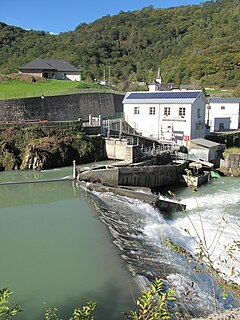
Small hydro is the development of hydroelectric power on a scale suitable for local community and industry, or to contribute to distributed generation in a regional electricity grid. Exact definitions vary, but a "small hydro" project is less than 50 megawatts (MW), and can be further subdivide by scale into "mini" (<1MW), "micro" (<100 kW), "pico" (<10 kW). In contrast many hydroelectric projects are of enormous size, such as the generating plant at the Three Gorges Dam at 22,500 megawatts or the vast multiple projects of the Tennessee Valley Authority.

Pumped-storage hydroelectricity (PSH), or pumped hydroelectric energy storage (PHES), is a type of hydroelectric energy storage used by electric power systems for load balancing. The method stores energy in the form of gravitational potential energy of water, pumped from a lower elevation reservoir to a higher elevation. Low-cost surplus off-peak electric power is typically used to run the pumps. During periods of high electrical demand, the stored water is released through turbines to produce electric power. Although the losses of the pumping process make the plant a net consumer of energy overall, the system increases revenue by selling more electricity during periods of peak demand, when electricity prices are highest. If the upper lake collects significant rainfall or is fed by a river then the plant may be a net energy producer in the manner of a traditional hydroelectric plant.
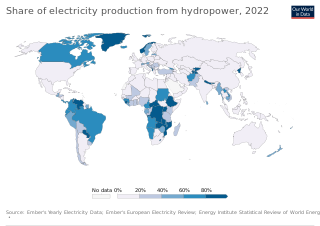
Hydroelectricity, or hydroelectric power, is electricity produced from hydropower. In 2020 hydropower generated one sixth of the world's electricity, almost 4500 TWh, which was more than all other renewables combined and also more than nuclear power.

Cogeneration or combined heat and power (CHP) is the use of a heat engine or power station to generate electricity and useful heat at the same time.
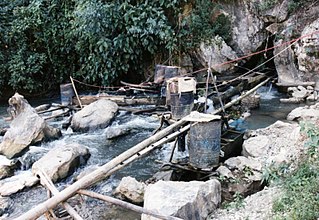
Micro hydro is a type of hydroelectric power that typically produces from 5 kW to 100 kW of electricity using the natural flow of water. Installations below 5 kW are called pico hydro. These installations can provide power to an isolated home or small community, or are sometimes connected to electric power networks, particularly where net metering is offered. There are many of these installations around the world, particularly in developing nations as they can provide an economical source of energy without the purchase of fuel. Micro hydro systems complement solar PV power systems because in many areas water flow, and thus available hydro power, is highest in the winter when solar energy is at a minimum. Micro hydro is frequently accomplished with a pelton wheel for high head, low flow water supply. The installation is often just a small dammed pool, at the top of a waterfall, with several hundred feet of pipe leading to a small generator housing. In low head sites, generally water wheels and Archimedes screws are used.

Run-of-river hydroelectricity (ROR) or run-of-the-river hydroelectricity is a type of hydroelectric generation plant whereby little or no water storage is provided. Run-of-the-river power plants may have no water storage at all or a limited amount of storage, in which case the storage reservoir is referred to as pondage. A plant without pondage is subject to seasonal river flows, thus the plant will operate as an intermittent energy source. Conventional hydro uses reservoirs, which regulate water for flood control, dispatchable electrical power, and the provision of fresh water for agriculture.

Pico hydro is a term used for hydroelectric power generation of under 5 kW. These generators have proven to be useful in small, remote communities that require only a small amount of electricity – for example, to power one or two fluorescent light bulbs and a TV or radio in 50 or so homes. Even smaller turbines of 200–300 W may power a single home in a developing country with a drop of only one meter. Pico-hydro setups typically are run-of-stream, meaning that a reservoir of water is not created, only a small weir is common, pipes divert some of the flow, drop this down a gradient, and through the turbine before being exhausted back to the stream.
The Mendip Power Group is a group of owners installing micro-hydroelectric turbines in a number of historic former watermills in the Mendip area of Somerset, England. The Group is one of several formed after the concept was developed by the South Somerset Hydropower Group.
According to the International Hydropower Association, Canada is the fourth largest producer of hydroelectricity in the world in 2021 after the United States, Brazil, and China. In 2014, Canada consumed the equivalent of 85.7 megatonnes worth of oil of hydroelectricity, 9.8% of worldwide hydroelectric consumption. Furthermore, hydroelectricity accounted for 25.7% of Canada's total energy consumption. It is the third-most consumed energy in Canada behind oil and natural gas.
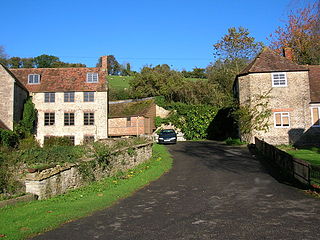
Gants Mill is a watermill on the River Brue in Pitcombe near Bruton, Somerset, England.

Torrs Hydro is a micro hydroelectric scheme, owned by the community, in New Mills, Derbyshire. It is located on the River Goyt, immediately after its confluence with the River Sett at the Torr weir. A 2.4-metre diameter steel trough screw turbine generates up to 63 kW of electricity.

Policy makers often debate the constraints and opportunities of renewable energy.

Tellisford Mill is a 55 kilowatts (74 hp) installed capacity micro hydro run-of-the-river power station on the site of a former watermill in the village of Tellisford in the Mendip district of Somerset, England. The mill lies on the River Frome, 5+1⁄2 miles (9 km) north-east of the town of Frome.
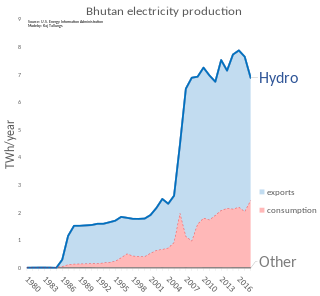
Energy in Bhutan has been a primary focus of development in the kingdom under its Five-Year Plans. In cooperation with India, Bhutan has undertaken several hydroelectric projects whose output is traded between the countries. Though Bhutan's many hydroelectric plants provide energy far in excess of its needs in the summer, dry winters and increased fuel demand makes the kingdom a marginal net importer of energy from India.

As of 2018, hydroelectric power stations in the United Kingdom accounted for 1.87 GW of installed electrical generating capacity, being 2.2% of the UK's total generating capacity and 4.2% of UK's renewable energy generating capacity. This includes four conventional hydroelectric power stations and run-of-river schemes for which annual electricity production is approximately 5,000 GWh, being about 1.3% of the UK's total electricity production. There are also pumped-storage hydroelectric power stations providing a further 2.8 GW of installed electrical generating capacity, and contributing up to 4,075 GWh of peak demand electricity annually.
Programme for Economic Advancement and Community Empowerment (PEACE), is a four-year project funded by the European Union. and implemented by the Sarhad Rural Support Programme (SRSP). It was launched in 2013 in all districts of Malakand Division, Khyber Pakhtunkhwa, Pakistan, namely, Swat, Shangla, Buner, Lower Dir, Upper Dir, Chitral and Malakand Agency.
The Moragolla Dam is a planned hydroelectric dam in Moragolla, Sri Lanka. The dam is to be 35 m (115 ft) high and is planned to create the 1,980,000 m3 (70,000,000 cu ft) Moragolla Reservoir with a maximum supply level at 548 m (1,798 ft) MSL. Upon completion, the Moragolla Power Station would have a gross installed capacity of 30 megawatts from two francis turbines, capable of generating approximately 85 GWh annually.
Micro hydropower to generate electricity in Nepal started with Pharping plant with an installed capacity of 500 kW in 1911 followed by Sundarijal and Panauti, in 1936 and 1965 respectively. Up to 1980, the focus was laid primarily on large-scale power generation through large hydro and thermal means, the micro-hydro potential remained untapped. In the first four years (1981–1985), the government started subsidising the micro-hydro plants. The number of plants has been increasing thereafter. Most of these plants are off-grid isolated plants serving for local villages. In 2000, Alternative Energy Promotion Centre was formed to look after the micro-hydropower in Nepal. It defined the plants in the range of 10-100 kW as micro hydropower. As of 2018, about 3000 microhydro projects have been installed contributing about 35 MW.